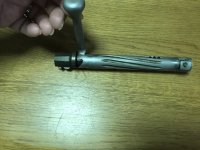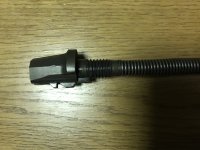You are using an out of date browser. It may not display this or other websites correctly.
You should upgrade or use an alternative browser.
You should upgrade or use an alternative browser.
Stainless bolt, alloy reciecer.
- Thread starter tjensen
- Start date
jackie schmidt
New member
I've seen actions with stanless recievers and alloy (41XX) bolts.
Are any actions the other way, stainless bolt and alloy reciever?
What brands then?
And if not, why?
Strength would be my guess. Most non precipitation hardening Stainless Steels do not have the impact ductility to be considered for the pressures imparted on a bolt in the lug area.
Precipitation hardening Stainless Steels such as 15-5 and 17-4 PH certainly have the strength, but at their ideal strength and machinability levels, have terrible anti gall qualities. If you were to make a bolt from one of these, H1050 would probably be the ideal strength level.
Years ago, Jim Farley made his bolts from S-7 tool steel. I have two of his early actions, the cast body ones, (cast 17-4), with the S-7 tool steel blots. Both have had thousands and thousands of rounds put through them and for all purposes, are still in as new condition.
The draw back to S-7 is the Hardenning and tempering temperatures, and time held at these temperatures, are extremely criticle to achieve the desired results.
The truth is, Chrome Moly Steel such as 4140 is probably still the best option. Ease of heat treat, ease of machining, and good strength and ductility are the reasons.
Last edited:
Thanks Jackie.
I was just wondering because I have access to prehardened european steel similar to 4130 in 38rc. Machines easily and beautifully. Then, on the other hand, a stainless, called 4418 here, also about 38hrc. Easy to machine also. But always heard not to make the bolt and reciever from the same material because of galling.
Whats your take on that?
I was just wondering because I have access to prehardened european steel similar to 4130 in 38rc. Machines easily and beautifully. Then, on the other hand, a stainless, called 4418 here, also about 38hrc. Easy to machine also. But always heard not to make the bolt and reciever from the same material because of galling.
Whats your take on that?
jackie schmidt
New member
Thanks Jackie.
I was just wondering because I have access to prehardened european steel similar to 4130 in 38rc. Machines easily and beautifully. Then, on the other hand, a stainless, called 4418 here, also about 38hrc. Easy to machine also. But always heard not to make the bolt and reciever from the same material because of galling.
Whats your take on that?
https://www.schmolz-bickenbach.us/f...nbach.us/documents/Ugitech/4418_Datasheet.pdf
The machinability of this steel is on par with 17/4 at H1150.
Yes, the accepted practice has always been that dis similar metals do, at the proper hardness levels, possess the best anti gall qualities.
Prehardened, or as we call commercial heat treat bars are fine for most applications.
But keep in mind, when trying to achieve the best results of strength and ductility, pieces should be roughed out and then hardened and tempered for the best results. It all has to do with what we call end quench hardnability.
If you have a piece of 4140 at 2 inches in diameter, and harden and temper it to 38 RC, that does not mean that it will be that hardness throughout. The very middle might be several points below. That is one reason why 4340 is a superior steel to 4140. It has a deeper Hardenning capability. In short, that means the steel has a better chance of achieving the correct properties throughout the piece when hardened and tempered to a given level of strength and ductility.
I like the 'trick' in the Panda action of having a steel insert in the aluminum to provide the threads for the barrel and the lug recesses.
The aluminum is not all that heavily loaded.
If you are willing to alter designs based on the material that will be used you could easily enlarge the lug cross section to make less than ideal strength materials operate.
All you need is adequate cross section of the lugs to make a safe action.
The aluminum is not all that heavily loaded.
If you are willing to alter designs based on the material that will be used you could easily enlarge the lug cross section to make less than ideal strength materials operate.
All you need is adequate cross section of the lugs to make a safe action.
Last edited:
Butch Lambert
Active member
Yes thats a nice way to save weight.
But I have this thing with aluminum and plastic.
Don't like them
As Brickeyee mentioned, the Panda receiver is great and I'm sure they're a couple thousand out there at this time. If I were to build another BR rifle I would choose a Panda drop port and I've owned several of the other receivers that are on the market.
Butch Lambert
Active member
Why?
Bedding surface?
No denying it looks good.
Quality and weight.
jackie schmidt
New member
Why?
Bedding surface?
No denying it looks good.
The truth?
If you want a Action for Short Range Benchrest that performs right out of the box, a Panda is hard to beat.
A lot has to do with the basic design. It uses a screw in shroud, which is easy to manufacture and fit so it is truly straight with the bolt body. (It's basically a Remington 700 design). It's simple and it works.
The aluminum body does give substantial bedding area, as well as reducing harmonics. They also have a substantial firing pin drop with the correct spring pressure.
If I were a Action Manufacturer, the last thing I would want splattered all over the Internet is Gunsmiths advertising that they can "fix" what ails the brand new action you just purchased.
You just don't here that about Pandas.
I have been around long enough to remember when a noted Gunsmith was "Truing" Panda's. When Kelbly got word of it, he was called out, and ceased the activity.
Butch Lambert
Active member
Umderstood.
So, are the raceways aluminum?
Yes, and they don't wear out.
jackie schmidt
New member
So.
The shroud is screwed in, not a press fit?
?
jackie schmidt
New member
Well I thought I read somewhere of pressfitting and gluing barrel shroud in aluminum. Have even seen it once in a homemade action. Also at least one shotgun maker glues the barrel on its trap shotgun in the monoblock. Not as much stress I know.
I think we are talking about two different things.
When I was speaking of a screw in bolt shroud, I was talking about the piece that encapsulates the cocking piece and secures the aft end of the firing pin.
This is the firing pin Assy out of my Rail Gun action, a Stiller Diamond Back Drop Port
http://benchrest.com/attachment.php?attachmentid=22199&stc=1&d=1553988889
http://benchrest.com/attachment.php?attachmentid=22200&stc=1&d=1553989398
Attachments
Last edited:



